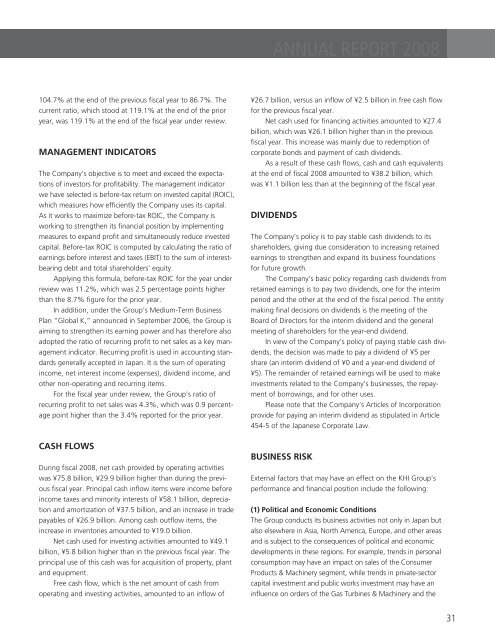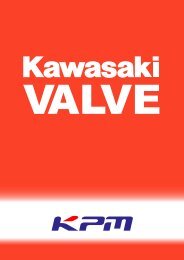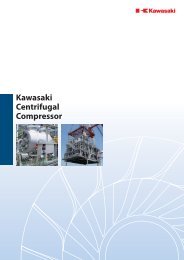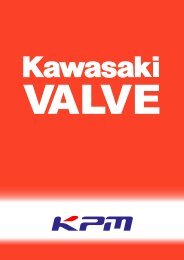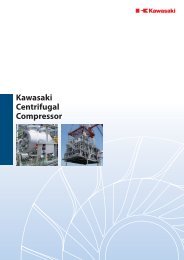KAWASAKI HEAVY INDUSTRIES, LTD.EuropeSales of motorcycles held strong in Europe, resulting in anincrease in sales of ¥32.8 billion, or 33.1%, to ¥131.6 billion,and a rise in operating income of ¥2.1 billion, or 88.3%, to¥4.5 billion.AsiaConsolidated sales in this region leaped ¥10.6 billion, or46.7%, to ¥33.3 billion, and operating income posted astrong increase of ¥0.8 billion, or 107.7%, to ¥1.5 billion.Other AreasSales in other areas declined ¥2.7 billion, or 21.0%, to ¥10.1billion, and operating income amounted to ¥0.3 billion,about the same as for the previous fiscal year.Cost, Expenses, and EarningsThe cost of sales rose ¥48.5 billion, or 4.0%, to ¥1,262.0 billion,in part because of the rise in raw material prices, but therate of increase in cost of sales was lower than the 4.3%increase in net sales. As a result, gross profit increased ¥14.0billion, or 6.2%, to ¥239.1 billion, and the gross profit marginrose 0.3 percentage point from 15.6% in the previous year to15.9% in the fiscal year under review.Selling, general and administrative expenses rose ¥6.2 billion,or 4.0%, to ¥162.2 billion. Operating income increased¥7.8 billion, or 11.2%, to ¥76.9 billion. The principal factorsleading to this rise in operating income were (a) the return toprofitability in the Shipbuilding and Plant & InfrastructureEngineering segments, (b) a weaker yen against the U.S. dollar,mainly in the first half of the fiscal year, and (c) the implementationof measures throughout the KHI Group to improveprofitability by reducing production and fixed costs and othermeans. As a result, the ratio of operating income to net salesrose 0.3 percentage point from 4.8% in the previous fiscalyear to 5.1% for the fiscal year under review.Other income (expenses) for fiscal <strong>2008</strong> amounted toexpenses of ¥18.9 billion versus ¥23.9 billion for the previousfiscal year. The principal factor accounting for this was anincrease in equity in income of non-consolidated subsidiariesand affiliates, which rose from income of ¥2.7 billion in theprevious fiscal year to ¥7.6 billion for the fiscal year underreview, representing an increase of ¥4.9 billion.As a result of the increase in operating income and thedecline in other expenses, income before income taxes andminority interests rose ¥12.8 billion, or 28.2%, to ¥58.1 billion.The ratio of net current and deferred income taxes toincome before income taxes and minority interests was37.9%, versus 33.8% for the previous year and lower than thestatutory tax rate of 40.5%. This difference was mainly due toan R&D tax credit for the year under review. As a result ofthese factors, after the deduction of minority interests in netincome of consolidated subsidiaries, net income for the fiscalyear increased ¥5.4 billion, or 18.0%, to ¥35.1 billion. Theratio of net income to net sales rose 0.2 percentage point,from 2.1% for the prior fiscal year to 2.3% for the fiscal yearunder review. ROE (calculated using average total net assets)increased 0.3 percentage point, from 11.1% to 11.4%.Capital expenditures for the fiscal year under reviewamounted to ¥50.5 billion, compared with ¥39.3 billion in theprevious fiscal year, and R&D expenses were ¥36.2 billion,versus ¥33.8 billion in the prior year.FINANCIAL CONDITIONTotal assets at the end of the fiscal year were ¥20.8 billion, or1.5%, higher than at the end of the previous fiscal year andamounted to ¥1,378.8 billion. Of this total, current assetswere ¥20.4 billion, or 2.1%, higher than at the end of theprior year and amounted to ¥982.3 billion. The principal reasonfor the increase in current assets was a rise in inventories,reflecting the Group’s high level of orders received. Amongother assets, investments and long-term loans were ¥17.3 billionlower than at the previous fiscal year-end, owing to thedrop in the value of investment securities, accompanying thegeneral decline in stock prices, and other factors. Net property,plant and equipment post a gain of ¥6.1 billion over the previousyear-end, reflecting the KHI Group’s active program ofcapital investments. Deferred tax, intangible and other assetswere up ¥11.6 billion year on year.Liabilities decreased ¥2.9 billion, or 0.3%, to ¥1,059.7 billion.This overall balance of liabilities was influenced mainly by(a) an increase of ¥18.5 billion in trade payables and (b) adecline in borrowings, bonds outstanding, and other interestbearingdebt of ¥27.8 billion, or 9.1%, to ¥276.4 billion.Current liabilities were up ¥18.0 billion, or 2.2%, to¥824.5 billion and long-term liabilities decreased ¥20.9 billion,or 8.2%, to ¥235.2 billion.Net assets rose ¥23.7 billion, or 8.0%, over the previousfiscal year-end, to ¥319.0 billion. The principal reason for thisincrease was the rise in retained earnings, reflecting the gain innet income for the fiscal year.The ratio of shareholders’ equity to total assets rose 1.3percentage points from 21.4% to 22.7%. In addition, thedebt-to-equity ratio showed a further substantial decline from30
ANNUAL REPORT <strong>2008</strong>104.7% at the end of the previous fiscal year to 86.7%. Thecurrent ratio, which stood at 119.1% at the end of the prioryear, was 119.1% at the end of the fiscal year under review.MANAGEMENT INDICATORSThe Company’s objective is to meet and exceed the expectationsof investors for profitability. The management indicatorwe have selected is before-tax return on invested capital (ROIC),which measures how efficiently the Company uses its capital.As it works to maximize before-tax ROIC, the Company isworking to strengthen its financial position by implementingmeasures to expand profit and simultaneously reduce investedcapital. Before-tax ROIC is computed by calculating the ratio ofearnings before interest and taxes (EBIT) to the sum of interestbearingdebt and total shareholders’ equity.Applying this formula, before-tax ROIC for the year underreview was 11.2%, which was 2.5 percentage points higherthan the 8.7% figure for the prior year.In addition, under the Group’s Medium-Term BusinessPlan “Global K,” announced in September 2006, the Group isaiming to strengthen its earning power and has therefore alsoadopted the ratio of recurring profit to net sales as a key managementindicator. Recurring profit is used in accounting standardsgenerally accepted in Japan. It is the sum of operatingincome, net interest income (expenses), dividend income, andother non-operating and recurring items.For the fiscal year under review, the Group’s ratio ofrecurring profit to net sales was 4.3%, which was 0.9 percentagepoint higher than the 3.4% reported for the prior year.CASH FLOWSDuring fiscal <strong>2008</strong>, net cash provided by operating activitieswas ¥75.8 billion, ¥29.9 billion higher than during the previousfiscal year. Principal cash inflow items were income beforeincome taxes and minority interests of ¥58.1 billion, depreciationand amortization of ¥37.5 billion, and an increase in tradepayables of ¥26.9 billion. Among cash outflow items, theincrease in inventories amounted to ¥19.0 billion.Net cash used for investing activities amounted to ¥49.1billion, ¥5.8 billion higher than in the previous fiscal year. Theprincipal use of this cash was for acquisition of property, plantand equipment.Free cash flow, which is the net amount of cash fromoperating and investing activities, amounted to an inflow of¥26.7 billion, versus an inflow of ¥2.5 billion in free cash flowfor the previous fiscal year.Net cash used for financing activities amounted to ¥27.4billion, which was ¥26.1 billion higher than in the previousfiscal year. This increase was mainly due to redemption ofcorporate bonds and payment of cash dividends.As a result of these cash flows, cash and cash equivalentsat the end of fiscal <strong>2008</strong> amounted to ¥38.2 billion, whichwas ¥1.1 billion less than at the beginning of the fiscal year.DIVIDENDSThe Company’s policy is to pay stable cash dividends to itsshareholders, giving due consideration to increasing retainedearnings to strengthen and expand its business foundationsfor future growth.The Company’s basic policy regarding cash dividends fromretained earnings is to pay two dividends, one for the interimperiod and the other at the end of the fiscal period. The entitymaking final decisions on dividends is the meeting of theBoard of Directors for the interim dividend and the generalmeeting of shareholders for the year-end dividend.In view of the Company’s policy of paying stable cash dividends,the decision was made to pay a dividend of ¥5 pershare (an interim dividend of ¥0 and a year-end dividend of¥5). The remainder of retained earnings will be used to makeinvestments related to the Company’s businesses, the repaymentof borrowings, and for other uses.Please note that the Company’s Articles of Incorporationprovide for paying an interim dividend as stipulated in Article454-5 of the Japanese Corporate Law.BUSINESS RISKExternal factors that may have an effect on the KHI Group’sperformance and financial position include the following:(1) Political and Economic ConditionsThe Group conducts its business activities not only in Japan butalso elsewhere in Asia, North America, Europe, and other areasand is subject to the consequences of political and economicdevelopments in these regions. For example, trends in personalconsumption may have an impact on sales of the ConsumerProducts & Machinery segment, while trends in private-sectorcapital investment and public works investment may have aninfluence on orders of the Gas Turbines & Machinery and the31
- Page 1 and 2: Annual Report 2008Year ended March
- Page 3: Consolidated Financial HighlightsKa
- Page 6 and 7: KAWASAKI HEAVY INDUSTRIES, LTD.Thus
- Page 8 and 9: An Interview with Tadaharu Ohashi,
- Page 10 and 11: KAWASAKI HEAVY INDUSTRIES, LTD.Q:Wh
- Page 12 and 13: AbcdeKawasaki Heavy Industries, Ltd
- Page 14 and 15: Review of OperationsKAWASAKI HEAVY
- Page 16 and 17: Review of OperationsKAWASAKI HEAVY
- Page 18 and 19: Review of OperationsKAWASAKI HEAVY
- Page 20 and 21: Review of OperationsKAWASAKI HEAVY
- Page 22 and 23: Review of OperationsKAWASAKI HEAVY
- Page 24 and 25: Review of OperationsKAWASAKI HEAVY
- Page 26 and 27: Review of OperationsKAWASAKI HEAVY
- Page 28 and 29: Six-Year Abcde SummaryKawasaki Heav
- Page 30 and 31: KAWASAKI HEAVY INDUSTRIES, LTD.annu
- Page 34 and 35: KAWASAKI HEAVY INDUSTRIES, LTD.Plan
- Page 36 and 37: Consolidated Balance SheetsKawasaki
- Page 38 and 39: Consolidated Statements of IncomeKa
- Page 40 and 41: Consolidated Statements of Cash Flo
- Page 42 and 43: Notes to the Consolidated Financial
- Page 44 and 45: KAWASAKI HEAVY INDUSTRIES, LTD.(r)
- Page 46 and 47: KAWASAKI HEAVY INDUSTRIES, LTD.(d)
- Page 48 and 49: KAWASAKI HEAVY INDUSTRIES, LTD.Basi
- Page 50 and 51: KAWASAKI HEAVY INDUSTRIES, LTD.(c)
- Page 52 and 53: KAWASAKI HEAVY INDUSTRIES, LTD.(a)
- Page 54 and 55: KAWASAKI HEAVY INDUSTRIES, LTD.The
- Page 56: KAWASAKI HEAVY INDUSTRIES, LTD.(d)
- Page 59 and 60: ANNUAL REPORT 2008EXECUTIVE OFFICER
- Page 61 and 62: ANNUAL REPORT 2008Paid-in CapitalEq
- Page 63 and 64: NetworkANNUAL REPORT 2008Kobe Head
- Page 65 and 66: Corporate DataANNUAL REPORT 2008Kaw


